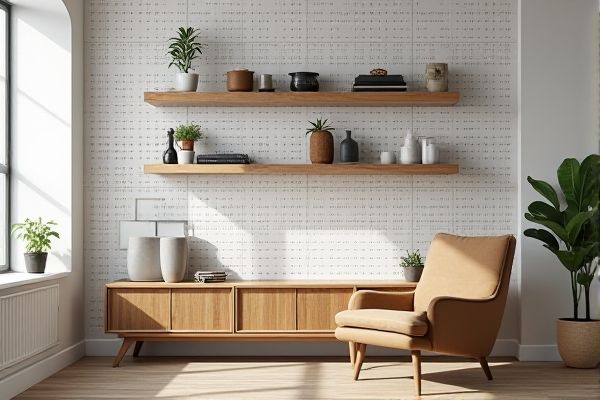
Slatwall offers versatile customization with horizontal grooves for adjustable hooks and shelves, making it ideal for displaying a wide range of items efficiently, while pegboard provides a budget-friendly, straightforward solution with evenly spaced holes for hanging tools and accessories. Discover how each system can transform your storage space and find the best option for your needs by reading the rest of the article.
Table of Comparison
| Feature | Slatwall | Pegboard |
|---|---|---|
| Material | Medium-density fiberboard (MDF) or metal | Wood, metal, or hardboard with holes |
| Design | Horizontal slats with grooves | Perforated board with evenly spaced holes |
| Load Capacity | Supports heavier items | Best for lightweight to medium items |
| Installation | Wall-mounted with screws, requires precise fitting | Easy to install, can be mounted on walls or panels |
| Flexibility | Customizable with various accessories and hooks | Compatible with peg hooks and baskets |
| Cost | Higher initial cost | Affordable, cost-effective option |
| Visual Appeal | Modern, sleek look | Simple and functional design |
| Common Uses | Retail displays, garages, workshops | Workshops, tool organization, retail |
Introduction to Slatwall and Pegboard
Slatwall and pegboard are popular wall storage solutions designed to maximize organization in workshops, garages, and retail spaces. Slatwall features horizontal grooves that securely hold compatible accessories, offering versatile customization for various tools and merchandise. Pegboard consists of evenly spaced holes to accommodate hooks and pegs, providing straightforward and flexible storage options for lightweight items.
Key Differences Between Slatwall and Pegboard
Slatwall features horizontal grooves designed for adjustable hooks and shelves, providing higher weight capacity and versatile storage options compared to pegboard's grid of evenly spaced holes suited for lightweight tools and accessories. Pegboard offers quick customization with easy peg rearrangement while slatwall panels support heavier, bulkier items, making them ideal for industrial or retail settings. Your choice depends on whether you prioritize flexibility with small tools (pegboard) or robust storage for larger items (slatwall).
Material and Durability Comparison
Slatwall panels are typically made from durable medium-density fiberboard (MDF) or PVC, offering superior strength and resistance to heavy loads compared to pegboard, which is commonly crafted from thinner wood-based fiberboard or metal. The denser composition of slatwall allows for greater longevity and less susceptibility to warping or damage under frequent use, while pegboard is more prone to wear and bending when supporting substantial weight. For environments requiring robust, long-lasting storage solutions, slatwall provides enhanced durability and material reliability over traditional pegboard systems.
Installation Process: Slatwall vs Pegboard
Slatwall installation involves mounting large panels directly onto wall studs, requiring precise measurements and secure anchoring for heavy items. Pegboard is easier to install using screws and anchors on drywall, offering a flexible grid for hooks and accessories but less load-bearing capacity. Your choice depends on the weight of items you plan to store and the wall type in your space.
Storage Capacity and Weight Load
Slatwall panels offer higher storage capacity and greater weight load support compared to pegboards, making them ideal for heavy or bulky items in retail or workshop settings. The horizontal grooves of slatwall accommodate a variety of hooks, shelves, and bins that can efficiently organize tools and merchandise while sustaining significant weight. Pegboards, while versatile and easy to install, generally support lighter items and have lower load limits due to their perforated structure and thinner material.
Aesthetic Appeal and Customization Options
Slatwall systems offer a sleek, modern aesthetic with a variety of finishes such as wood, laminate, or metal, allowing for high customization in both style and color to match diverse interior designs. Pegboards provide a more utilitarian look, typically made from perforated hardboard or metal, but they excel in flexibility with numerous hooks and accessories for customizable tool or merchandise organization. Choosing between slatwall and pegboard depends on the desired balance between polished appearance and versatile display options.
Versatility and Accessory Compatibility
Slatwall offers superior versatility and accessory compatibility with a wide range of hooks, shelves, bins, and brackets that can support heavier items and be easily rearranged. Pegboard provides a cost-effective solution with numerous peg types and hooks but is generally less sturdy and limited in holding heavier tools or equipment. For extensive storage customization in retail or workshop environments, slatwall systems deliver more adaptable and durable accessory options.
Cost Analysis: Slatwall vs Pegboard
Slatwall panels typically cost more upfront than pegboard due to their durable materials and sleek design, with prices ranging from $30 to $50 per panel compared to pegboard's $10 to $20 per sheet. While pegboard offers a budget-friendly option for basic storage, slatwall provides greater long-term value by supporting heavier loads and customizable accessories that reduce the need for frequent replacements. Your choice should consider both initial investment and ongoing durability to maximize cost efficiency in organizing spaces.
Maintenance and Longevity
Slatwall panels offer superior durability and require minimal maintenance compared to pegboards, which can wear out or warp over time due to frequent peg placement. You benefit from the slatwall's high load-bearing capacity and easy-to-clean surfaces, ensuring a longer lifespan in both retail and workshop settings. Choosing slatwall can reduce replacement costs and downtime associated with pegboard repairs or replacements.
Choosing the Right System for Your Space
Slatwall offers versatile customization with adjustable shelves and hooks, ideal for retail or garage organization where heavy-duty storage is needed. Pegboard provides a cost-effective, lightweight solution perfect for small workshops or craft rooms, allowing easy repositioning of tools and accessories. Assess your space requirements, weight capacity, and aesthetic preferences to determine the best fit for optimal functionality and style.
 homyna.com
homyna.com